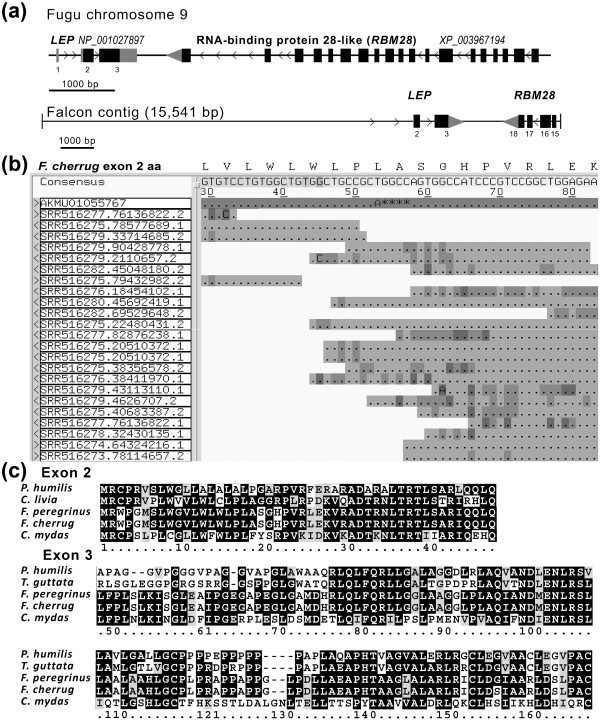Figure 1.

Synteny, shotgun assembly, and sequence alignments of avian leptin-like genes. (a) Comparison of genomic region of fugu (Takifugu rubripes) LEP based on the NCBI Sequence Viewer display, and falcon contig assembly [GenBank: AKMT01018335–6, AKMU01055766–7]. Gene structures are drawn to scale shown by the bar below. Black and gray boxes represent translated and untranslated regions (UTRs) of exons, respectively. When the exact transcription termination site is not characterized, large gray arrowheads at the 3′ UTRs indicate the direction of transcription, which is generally indicated by small arrowheads on the intron delineations. Gene identification and exon numbers are given above and below the gene depictions, respectively. Exon numbers for falcon RBM28 follow their numbering in the orthologous rat gene. (b) Identification of errors in the genome submission of falcon based on alignment with individual reads from Sequence Read Archive (SRA). Reads were located by BLASTN search of the SRA database, downloaded with their quality information (FASTQ format), and assembled using GAP5 software [8]. The relevant protein sequence is added above the contig editor output for a region of low coverage within the second LEP exon. The contig editor shows quality values by gray scale and discrepancies between the sequences and the consensus are highlighted by a base symbol. The cutoff option was not turned on and therefore low quality (dark gray) bases that were manually trimmed are not displayed. Individual reads and the mapping template (AKMU01055767) are identified on the left. A base substitution and 4-base deletion (A****) are denoted on the mapping template, which is the first read below the consensus line. (c) Amino acid sequences of leptin-like genes identified in the WGS database of birds:tit (Pseudopodoces humilis, [GenBank: HG425120]), dove (Columba livia, [GenBank: HG425123]), falcons (Falco peregrinus, [GenBank: HG425121]; and F. cherrug, [GenBank: HG425122]), and finch (Taeniopygia guttata, [GenBank: XP_004175839]) were compared with turtle LEP (Chelonia mydas, [GenBank: KB475412]). Box coloration follows the legend of Figure 2.
